In the world of NFTs, liquidity remains a pivotal challenge. Traditional trading methods, whether sale-based or auction-based, often result in high capital requirements and low efficiency. Solvent, reimagined by IkigAI Labs XYZ, is a platform designed to infuse liquidity into the NFT market, revolutionizing how digital art assets like our Genesis Collection are traded.
The Genesis of Liquidity
Solvent introduced a unique system of "buckets" and "droplets" to facilitate instant liquidity. For IkigAI Labs XYZ's Genesis Collection, comprising 12 icons with 24 images each, released in editions of 15, this system could offer a solution to fix the liquidity challenge. Each icon can have its dedicated bucket, allowing NFT holders to deposit their assets and receive droplets, which are fungible tokens representing the floor price index of that particular icon.
Instant Liquidity and Dynamic Pricing
Unlike traditional marketplaces, Solvent can provide immediate liquidity through droplets. This system may be beneficial for the Genesis Collection, allowing for real-time price discovery and instant liquidity, bypassing the lengthy and uncertain process of listing and waiting for buyers.
How Pricing Discovery Works
Consider the Genesis Collection's unique structure: each icon's bucket on Solvent allows for the deposit of specific NFTs. Upon deposit, droplets are minted and assigned a value based on the supply and demand within the liquidity pools on AMMs like Raydium. This dynamic pricing mechanism is crucial for accurately valuing the diverse and limited editions within the Genesis Collection.
Why Solvent is More Efficient
The traditional method of determining NFT value post-sale is inefficient, especially for unique collections like Genesis. Solvent's approach, where the value is determined by the liquidity pool status, offers a more constant and fair pricing mechanism, enhancing capital efficiency.
Establishing Liquidity
To ensure smooth transactions for the Genesis Collection's droplets, sufficient liquidity must be added to the Serum markets. This approach may prove effective for both high and low-floor price assets, making it potentially a good solution for the diverse valuations within a Collection, not unlike the Ikigai Labs Genesis Collection. For executing smoother transactions on the droplets, sufficient liquidity needs to be added to the Serum markets for those droplets. Users holding droplet tokens of NFT projects can add their liquidity to the pools to earn trading fees as well as yield farming rewards.
Liquidity Rewards
Users providing liquidity are rewarded with governance tokens. This incentivizes early and continued participation in the liquidity pools, benefiting both the platform and the users. This may open up numerous possibilities:
- Fractionalized Ownership.
- NFTs for Lending.
- Floor Perpetuals.

Token Staking? LPs can stake tokens to obtain benefits such as a portion of the minting fee charged by the platform being used to open market buyback of tokens, which are distributed amongst the stakers.
Minting fee discounts? Based on the amount that is staked, users can get reduced minting fees to use the platform.
Future Developments
IkigAI Labs XYZ may explore integrating real-time Oracle feeds for dynamic pricing, release an SDK for developers, and explore multi-chain integrations. Our plan includes onboarding EVM NFTs to Solana programmatically via Wormhole Bridge and creating instant liquidity and lending features for those NFTs as well.
Since each droplet represents a hundredth of an NFT asset in any NFT project, we can compute the floor price of an NFT project in terms of USDC at any given time by multiplying the real-time price of the droplet for that project. Real-time feeds and quotes for the changes in the price of these droplets can be created by integrating with oracles on-chain.
The focus will be on enhancing the liquidity of the Genesis Collection.
github.com/IkigaiLabsETH/solvent

Art is tough to trade. NFTs are like rare, mystical artifacts, each locked in its own little world, making them pretty illiquid.
Let's say you had a digital masterpiece from an iconic creator. You love it, but you need some internet money. In the old days, you'd have to list it in a marketplace, set a price, and wait... and wait... But with this concept, you could just pop your NFT into this magical thing called a "bucket." In return, you'd get "droplets" – these were like little pieces of magic that represented the value of your NFT.
These droplets weren't just any tokens; they were a snapshot of your NFT's worth in the digital art market. You could trade them, swap them, and do all sorts of wizardry on platforms like Serum. Now, let's talk about the secret sauce – the way to figure out what your NFT is worth. It was like having a wise old sage who could look at the market, see what everyone was doing, and give you a fair price for your digital art. This sage wasn't swayed by just one sale; it looked at the whole picture, making sure you got a price that made sense.
As for the treasure that could power IkigAI 2.0, it may or may not be something like an $LTL token, some sort of key to the kingdom. Holding $LTL could mean you have a say in how IkigAI evolves. It is like being part of an exclusive council of wizards, shaping the future of this marketplace aggregator, still under construction.
The journey of IkigAI is just beginning. It has big plans – even bridging worlds by bringing in NFTs from lands like Ethereum. The MFers at IkigAI are now the ones picking which NFTs get to join the party. They are like the hosts of an exclusive gala, making sure everything is just right for their guests. They aim for a future where trading digital art is as easy as sharing stories around a campfire. 🔥

